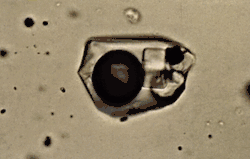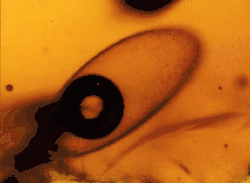Fluid inclusion
A fluid inclusion is a microscopic bubble of liquid and gas that is trapped within a crystal. As minerals often form from a liquid or aqueous medium, tiny blebs of that liquid can become trapped within the crystal, or along healed crystal fractures. These small inclusions range in size from 0.01 to 1 mm and are usually only visible in detail by microscopic study.

These inclusions occur in a wide variety of environments. For example, they are found within cementing minerals of sedimentary rocks, in gangue minerals such as quartz or calcite in hydrothermal circulation deposits, in fossil amber, and in deep ice cores from the Greenland and Antarctic ice caps. The inclusions can provide information about the conditions existing during the formation of the enclosing mineral.
Hydrothermal ore minerals typically form from high temperature aqueous solutions. The trapped fluid in an inclusion preserves a record of the composition, temperature and pressure of the mineralizing environment. An inclusion often contains two or more phases. If a vapor bubble is present in the inclusion along with a liquid phase, simple heating of the inclusion to the point of resorption of the vapor bubble gives a likely temperature of the original fluid. If minute crystals are present in the inclusion, such as halite, sylvite, hematite, or sulfides are present, they provide direct clues as to the composition of the original fluid.
In the recent years, fluid inclusion research has been extensively applied to understand the role of fluids in the deep crust and crust-mantle interface. Fluid inclusions trapped within granulite facies rocks have provided important clues on the petrogenesis of dry granulite facies rocks through the influx of CO2-rich fluids from sub-lithospheric sources. CO2-rich fluid inclusions were also recorded from a number of ultrahigh-temperature granulite facies terranes suggesting the involvement of CO2 in extreme crustal metamorphism. Some recent studies speculate that CO2 derived by sub-solidus decarbonation reactions during extreme metamorphism has contributed to the deglaciation of the snowball Earth (Santosh and Omori, 2008).

Fourier transform infrared spectroscopy and Raman spectroscopy can be used to determine the composition of fluid inclusions.[1]
Paleoclimate applications
Trapped bubbles of air and water within fossil amber can be analyzed to provide direct evidence of the climate conditions existing when the resin or tree sap formed. The analysis of these trapped bubbles of air provides a record of atmosphere composition going back 140 million years. The data indicate that the oxygen content of the atmosphere reached a high of nearly 35% during the Cretaceous Period and then plummeted to near present levels during the early Tertiary . The abrupt decline corresponds to or closely follows the Cretaceous–Paleogene extinction event and may be the result of a major meteorite impact that created the Chicxulub Crater.
Air bubbles trapped within the deep ice caps can also be analyzed for clues to ancient climate conditions.
See also
- Melt inclusions
- Inclusion (mineral)
References
- Mormone, A., Piochi, M., Bellatreccia, F., De Astis, G., Moretti, R., Della Ventura, G., & Mangiacapra, A. (2011). A CO2-rich magma source beneath the Phlegraean Volcanic District (Southern Italy): Evidence from a melt inclusion study. Chemical Geology, 287(1), 66-80
- Fluid inclusions - USGS
- Amber inclusion - USGS*What are fluid inclusions*Fluid Inclusion Research at NUI, Galway.
- Dino Breath: fluid and air inclusions in Dominican Amber
Santosh, M., Omori, S., CO2 windows from mantle to atmosphere: Models on ultrahigh-temperature metamorphism and speculations on the link with melting of snowball Earth. Gondwana Research 14, in press, doi:10.1016/j.gr.2007.11.001, 2008.